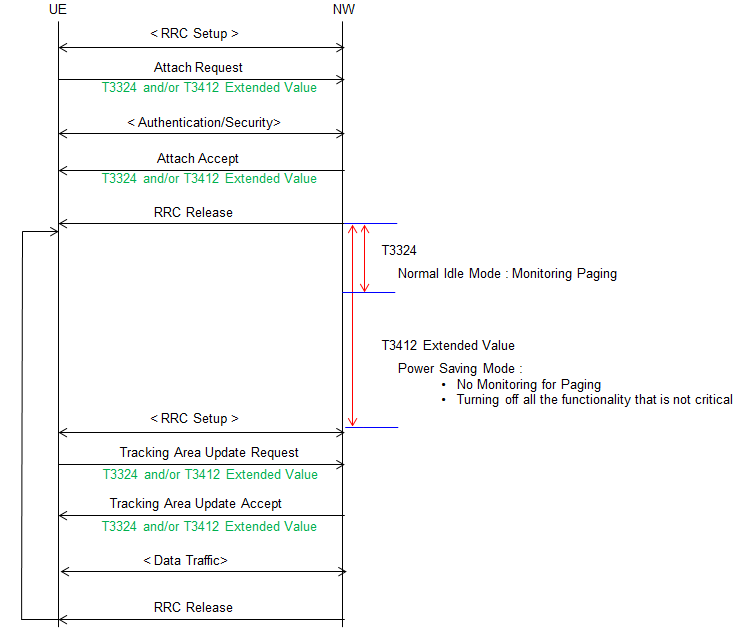|
4G/LTE - Power Saving |
||
|
PSM (Power Saving Mode)
What is PSM ? It stands for Power Saving Mode and it means as it literally says. It is a specially kind of UE status that can minimize the energy consumption that is supposed to be even lower than normal idle mode energy consumption. This is newly added feature in Release 12 and is specified in 3GPP 24.301-5.3.11 Power saving mode and 23.682-4.5.4 UE Power Saving Mode.
Based on 23.682-4.5.4 UE Power Saving Mode, PSM is defined as follows.
As the term 'Power Saving' implies, the main purpose of this feature is to minimize energy consumption while the device is not transmitting or receiving anything. Then the question is 'How low the energy consumption goes when a device is in power saving mode ?'. The target is to keep the energy consumption is almost as if the device is OFF and lower than the energy consumption of Idle mode. (See a good live demo for this in Ref [1])
Overall mechanism of PSM goes as follows and this would be a critical feature of MTC devices using LTE (like Category 0 device). The two timers are involved in this process. Based on 23.682-4.5.4 UE Power Saving Mode, UE and Network does as follows.
Followings are set of examples of NAS messages which configures the two timers. In terms of the timer parameters, all the messages have the same structure
< Attach Request/Attach Accept/Tracking Area Update Request/Tracking Area Update Accept >
Attach request ::= DIVISION ... +-T3324 value ::= TLV OPTIONAL:Exist | +-Octet1 ::= DIVISION | | +-GPRS Timer 2 IEI ::= IEI [6A] | +-Octet2 ::= DIVISION | | +-Length of GPRS Timer 2 contents ::= LEN (0..255) [1] | +-Octet3 ::= DIVISION | +-Unit ::= CHOICE [value is incremented in multiples of 2 seconds] // Unit field has following options // value is incremented in multiples of 2 seconds // value is incremented in multiples of 1 minute // value is incremented in multiples of decihours // value indicates that the timer is deactivated | +-GPRS timer2 value ::= INT (0..31) [10] +-T3412 extended value ::= TLV OPTIONAL:Exist +-Octet1 ::= DIVISION | +-GPRS Timer 3 IEI ::= IEI [5E] +-Octet2 ::= DIVISION | +-Length of GPRS Timer 3 contents ::= LEN (0..255) [1] +-Octet3 ::= DIVISION +-Unit ::= CHOICE [value is incremented in multiples of 1 hour] // Unit field has following options // value is incremented in multiples of 10 minutes // value is incremented in multiples of 1 hour // value is incremented in multiples of 10 hours // value is incremented in multiples of 2 seconds // value is incremented in multiples of 30 seconds // value is incremented in multiples of 1 minute // value is incremented in multiples of 320 hours // Rel14 or later(24.008) // value indicates that the timer is deactivated. +-Timer value ::= INT (0..31) [12]
What value to set for these timers ?
As you see, the rage of the timer values you can set for these timers are pretty wide. Especially the range for 'extended value' would rage from a couple of minuites to over 400 days. Basically it is completely up to Network Operators to specify the timer. However, to make various devices globally and seamlessly and globaly it would be good to have some guidelines for the settings. Recently (Oct 2017), GSMA put forward some kind of guideline for this in 6.1 PSM Standalone Timers in LTE-M Deployment Guide.
Reference :
[1] Live demo: Improving IoT Device Battery Life with Network Power Saving Mode for LTE and GSM Devices (YouTube) [2] 24.301-8.2.1.12 T3412 extended value [3] C1-113207 : Regarding T3412 Extended Value [4] LTE Cat-0ís Power Saving Mode: What it Could Mean for Cellular IoT [5] GSMA LTE-M Deployment Guide
|
||
